#morel hunting
Photo
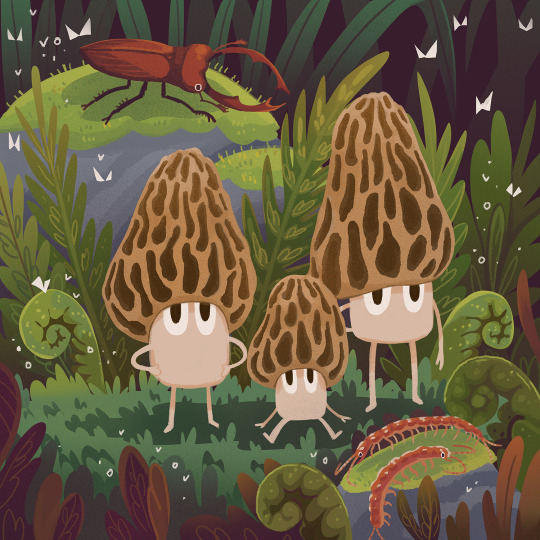
Morel folk on the forest floor with some bug friends!
My shop
#morels#morel hunting#morel mushrooms#mushroom folk#mushroom characters#fun guys#cw centipede#tw centipede#north american stag beetle
491 notes
·
View notes
Text

morel on 35mm, shot by me in Oklahoma
#shotbyme#filmisnotdead#35mm#dark photography#film photograhers#creepy#film photography#film#mushroom hunting#morel hunting#morel#morel mushrooms#mushrooms#mushroom photography#mushroom#mycology#mycologist
2 notes
·
View notes
Text


Baby's first morel of the season 🍄🌿🔍
#babys first morel of the season :)#morel#morel hunting#foraging#forage#nature#outdoors#mushroom#fungus#forest#hiking
57 notes
·
View notes
Text
Ever stood in a meadow while it’s raining? Ever gone looking for morels and found some peace instead?
#forager#certified mushroom expert#morel hunting#mushrooms#rain#forest#video#meadow#calm#bird song#mixed forest
3 notes
·
View notes
Text

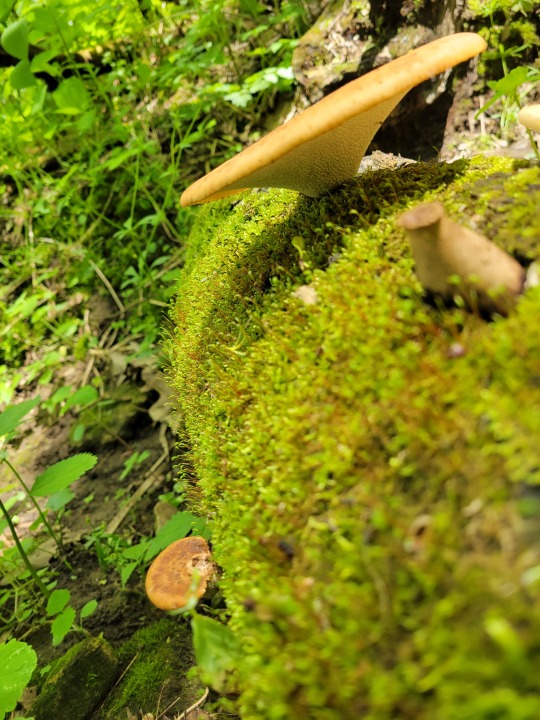
UFO (Unidentified Fungal Object)
...probably polypore. Also, M O S S!!
#M O S S!!#Morel hunting#Polypore hunting#Naturecore#Forestcore#goblincore#forestcore#naturecore#dirtcore#forest cottage#cottagecore
28 notes
·
View notes
Text
Morel Time
If you’re a morel mushroom lover, it’s about time. We need temperatures in the low 70s and night temperatures in the 50s. They are usually found around the bases of elms, ashes, and cottonwoods. The season is only a couple of weeks long so don’t put it off.
When hunting morels, use a mesh or breathable bag. That way, the spores can escape to make more for next year.
I usually bring them home and…
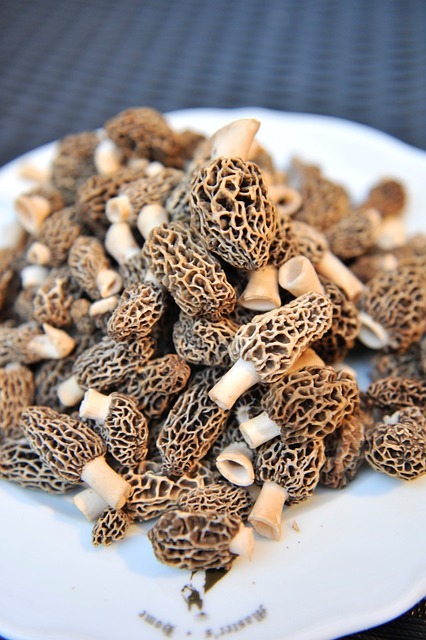
View On WordPress
0 notes
Text
I am all for creative sushi, but not when the creator doesn't fully understand the ingredients. A sushi restaurant in Montana served people sushi with raw and very undercooked morel (Morchella spp.) mushrooms on it. Over fifty people ended up sick with gastrointestinal upset, and two people actually died. Other restaurants that served the same batch of morels, fully cooked, had no such issues, and there was no evidence that there was any mishandling of the morels that could have caused a bacterial or other contamination. So it's pretty clear that the raw morels themselves were to blame.
Yes, there are a few wild mushroom species you can eat raw, and only in small amounts). No, Morchella are not among them. Morels have a toxin in them that's neutralized by cooking; Paul Stamets theorized that it's hydrazine, but no one has been able to isolate hydrazine in a morel yet so that's not a done deal. Whatever it is, there's enough of it that it tends to give people nasty gastrointestinal upset when they eat raw morels, even in small quantities. This is the first I've heard of people dying from it.
It's not the only time I've heard of people dying from consuming a commonly-considered-edible mushroom, though. There were two separate incidents--2004 and 2009--in which several people who ate angel wing mushrooms (Pleurocybella porrigens) died of encephalopathy. Now, it did turn out that most of the people sickened had pre-existing liver and/or kidney issues. And a 2011 study identified an unstable amino acid, now named Pleurocybellaziridine, as the possible fatal factor that was found in large quantities in angel wings. It could be that the culprits were flushes of these mushrooms with abnormally high amounts of Pleurocybellaziridine. But you can't tell how much of a given metabolite a given mushroom has just by looking at it, and so that raises enough of an alarm for me personally that as a forager I just put angel wings on the "do not eat" list.
Will I continue to eat morels? Yes. The toxicity associated with raw morels has been known for a long time, and there have been no recorded issues with thoroughly cooked morels (the angel wings were also cooked, meaning the toxin is not thermolabile.) And as mentioned before, almost any edible wild mushroom is going to give you gastrointestinal issues if you eat it raw. The mushrooms you get at the store are a weird outlier that can be safely eaten raw. And by the way, button mushrooms, criminis, and portobellos are all the same species--Agaricus bisporus--at different stages of development.
This is why I emphasize in my foraging classes that you should always cook your wild mushrooms thoroughly, and if you're trying a new species for the first time only eat a small amount and then wait a few days to make sure you don't have any reactions. As the saying goes, there are old mushroom hunters and there are bold mushroom hunters, but there are no old, bold mushroom hunters.
#mushrooms#mushroom hunting#mushroom foraging#foraging#edible mushrooms#morels#Morchella#fungi#fungus#mycology#poisonous mushrooms#nature#food#foragers#wild mushrooms#sushi#Montana#food safety
1K notes
·
View notes
Text

Went Morel harvesting today! They like fresh burned area so we hiked across a pretty sketchy burn from last year. I fell in a hole but it was totally worth it.
223 notes
·
View notes
Text

Couldn't decide on a bird to sketch so I went with a Morel instead.
#art#illustration#sketch#sketchbook#artist#artwork#nature#mushrooms#mushroom art#nature art#morel#morel mushroom#mushroom#mushroom hunting
7 notes
·
View notes
Text
You know Jean is getting adopted by Lena and Morell when they drop the news
#de headcanon#I’m like 85% sure. that’s almost 100% according to andre#and before anyone says they wouldn’t adopt jean let me gently remind you that they adopted gary#gary. fascist who doesn’t really care about cryptids#meanwhile the passion radiating from JV’s direction is PALPABLE when he sees the phasmid photo#you know he’d be ABSORBED when lena and morell tell him about more cryptids#cryptozoologist jean vicquemare you just watch him pin up all the crypto sighting clippings on all the walls in his little flat#you know it’s gonna be one of his few obsessions for the next 20 years#an abundance of love from Lena and Morell would do him so much good. so much good#and he can even bond with harry again over it. not just the job anymore#kim to harry: you can really use a hobby. like gardening or track and field or whatever#now jv and hdb can go on cryptid hunts together after work and on weekends#jean vicquemare#lena the cryptozoologist’s wife#morell the cryptozoologist#de#disco elysium
17 notes
·
View notes
Photo


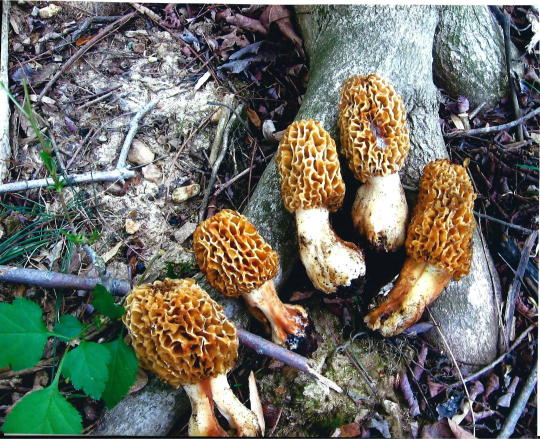
Mycelium?

27 notes
·
View notes
Text

morel on 35mm, shot by me in Oklahoma
#shotbyme#filmisnotdead#35mm#dark photography#film photograhers#film photography#film#mushrooms#morel mushrooms#morel#morel hunting#mushroom hunting#mycology#mycologist#mushroom photography
3 notes
·
View notes
Text
‘Tis the season! Wish I knew where to find such a tasty and supportive morsel. Yes, that is a clever anagram. 🤓
Photo source: Mushroom Mobile Home FB page

#morsel#morels#mushrooms#mushroom hunting#foraging#springtime#rainy season#time to find a local source that sells morels#morel mushrooms#morel support#anagrams#you can do it
4 notes
·
View notes
Text
Miso soup with morels instead of shiitakes. 10/10 would recommend.
#Morel hunting#Foraging#tradfem#tradwife#traditional gender roles#traditional marriage#traditional family#traditional femininity#forestcore#naturecore#goblincore#dirtcore
4 notes
·
View notes
Note
What is your favorite mushroom
Tough call, honestly. I am going to divide the answer into "favorite mushroom to eat" vs. "favorite in general."
My favorite mushroom to eat is definitely Morel mushrooms. They are very tender and really do have a nice beef flavor. They are also super interesting shrooms. Morels do not have gills that release spores, but they have "pits" all over their caps. These pits produce cream/yellow spores. They are also completely hollow when cut open.
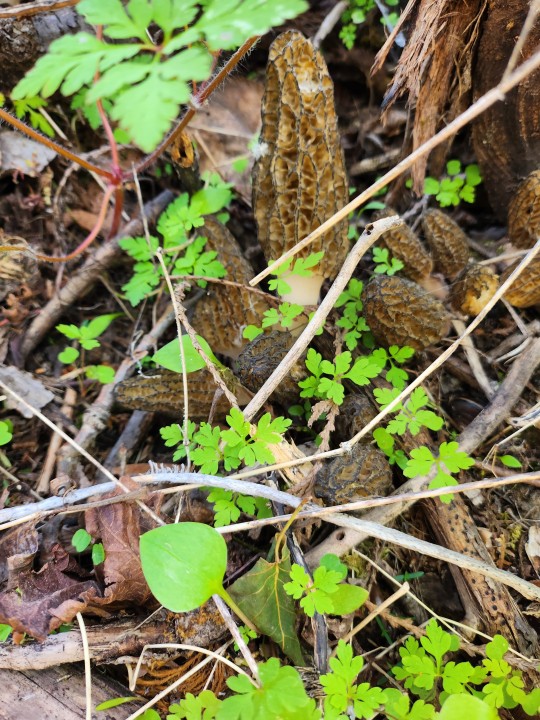

In Poland, Morels were thought to be the work of the devil or signs of his work. According to german legend, the devil turned an old woman into a mushroom. To this day, it is an insult to call an older woman a "Morel."
● ● ●
My favorite mushroom in general would definitely be the Oyster mushroom. They were the first mushroom I was reliably able to ID. Oysters are also super popular edibles and can be cooked in many different ways. They have a delicious shellfish flavor and a lot of health benefits.

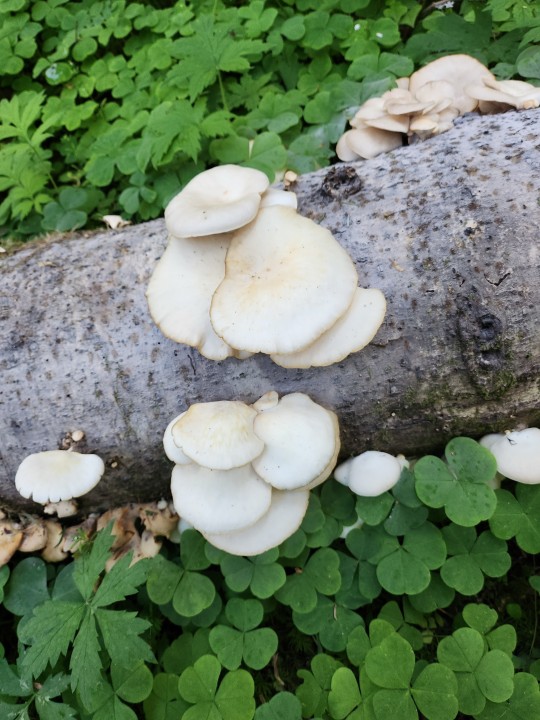
I love coming across these mushrooms on hikes. They always grow in large, beautiful clusters. They always grow on trees/logs, which is cool to see. They also hunt nematodes (tiny worms) by releasing a toxin that paralyzes and dissolves them. The resulting nematode goo is easier for the Oysters to digest. Hunting is an incredibly badass activity for a shroom to do! 😎
Thanks for the question, anon. Had to do some thinking about it. 👍🏾👍🏾
#oyster mushrooms#mushroom hunting#foraging#forage#edible shrooms#morels#morel mushrooms#fungus#mushrooms
3 notes
·
View notes
Text
How to Identify Morels
Originally posted at my website at https://rebeccalexa.com/how-to-identify-morels/ - Click here to learn more about the How to Identify article series.
Name: True morels (Morchella spp.)
Range and typical habitat(s): Widespread throughout temperate North America, Europe, New Zealand and Australia; less commonly reported in South America, Asia, and coastal Africa. Morels are commonly found in wooded areas, and many species grow primarily on soil; these may have symbiotic (though not necessarily mycorrhizal) relationships with trees and other plants. Other morels, such as M. importuna, are saprotrophs that happily colonize dead wood, to include mulch used in landscaping. At least one, the white morel M. rufobrunnea, may be capable of both lifestyles. Morels are exceptionally difficult to cultivate, and no large-scale cultivation method has been developed as of this writing.
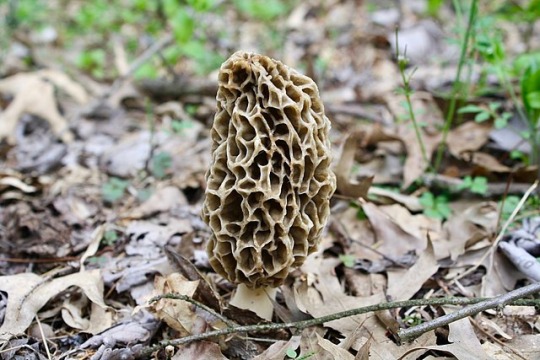
M. americana
Both deciduous and conifer forests may be homes to morels; yellow morels tend toward deciduous, while conifer forests are more likely to feature black morels. A wide variety of tree genera may be associated with morels include but are not limited to Pseudotsuga, Pinus, Abies, Quercus, Fraxinus, Alnus, and Castanea.
However, the half-free morels–M. punctipes (seen below), M. populiphila, and M. semilibera–may have a small space between the bottom edge of the cap and the stipe. The cap has a honeycombed appearance, with surfaces deeply pockmarked with cavities surrounded by brittle ridges that crumble into fragments when crushed. Colors vary, and morel species are often grouped together by cap color; black morels have a dark brown to black cap, while yellow and white morels are more tan to cream.

M. punctipes, cut in half to show hollow centers, and only the upper portion of the caps attached to the stipes. Photo by Chase G. Mayers, CCA-4.0
The stipe may be lightly textured, and is usually lighter in color than the cap, often white, cream, or pale yellow depending on species. Cutting a morel’s stipe open reveals that it is entirely hollow inside. A mature morel is generally around three to six inches high, though larger specimens have been found.

M. americana with the top removed, showing the hollow interior.
The stipe may be lightly textured, and is usually lighter in color than the cap, often white, cream, or pale yellow depending on species. Cutting a morel’s stipe open reveals that it is entirely hollow inside. A mature morel is generally around three to six inches high, though larger specimens have been found.
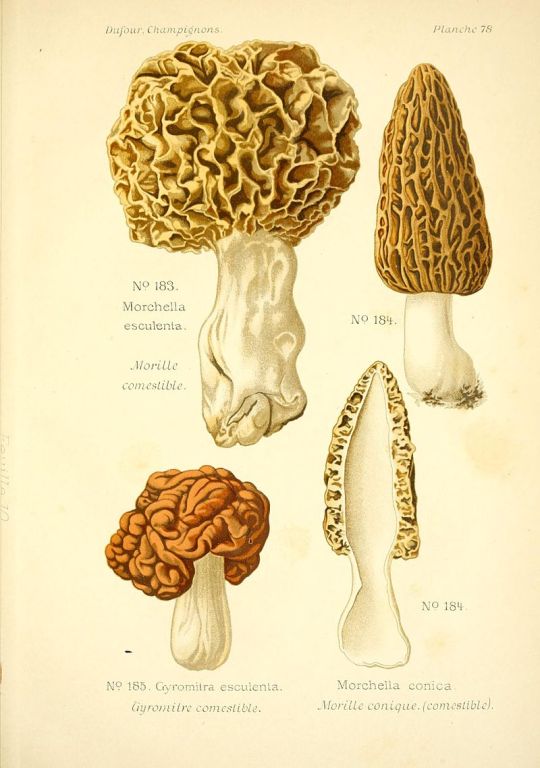
A vintage illustration shows three morels, to include one cut in half to display the hollow center; the mushroom in the lower left is a false morel (Gyromitra esculenta).
Other organisms it could be confused with and how to tell the difference: There are multiple groups of mushrooms that look similar enough to morels to cause confusion; given morels are a popular edible mushroom, consumption of some of these lookalikes has caused serious illness on numerous occasions.

V. bohemica; note that the bottom edge of the cap is not attached to the stipe, and that it has more of a wrinkled appearance than honeycombed. By NeoSporen, CCA-SA-3.0.
Members of the genus Verpa look similar to half-free morels in that the bottom edge of the cap is not attached to the stipe. However, when cut in half the half-free morels have more of the upper portion of the cap attached to the stipe; Verpas only have the very tip attached. Outwardly they do look quite similar to morels overall, often having a conical cap with a honeycombed texture; some may have less distinct cavities and a more “lumpy” appearance rather than honeycombed. The cap of the Verpa is generally smaller in proportion to the stipe than on mature morels. The stipes of young Verpas are full of soft, fluffy hyphae, but they become hollow like morels as they mature.
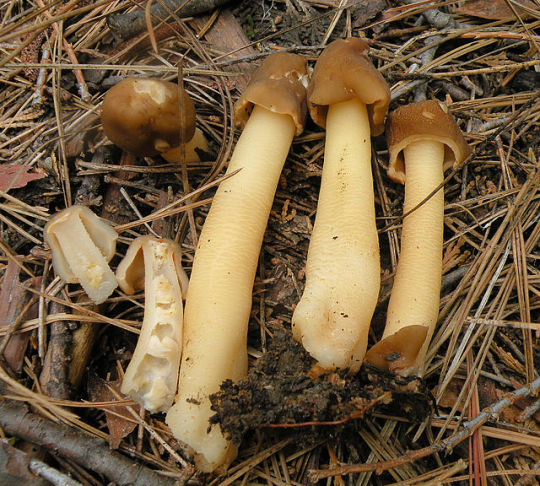
V. conica, showing one cut in half. Note that the cap is only attached to the stipe at the very top, and there is still some fungal hyphae tissue in the center of the stipe. Photo by Jeff Riedenauer (Tamsenite), CCA-SA-3.0.
Like morels, they are considered by some to be edible when thoroughly cooked. However, one study purports that V. bohemica is also toxic, having the same sort of toxins as the false morels I’ll discuss below. Some field guides recommend avoiding the other Verpa species as well due to potential inedibility. Both Verpas and morels fruit in spring, and may sometimes be found in the same area. As someone who would like to become an old, rather than bold, mushroom hunter, I recommend skipping the Verpas and sticking to the true morels, just in case.
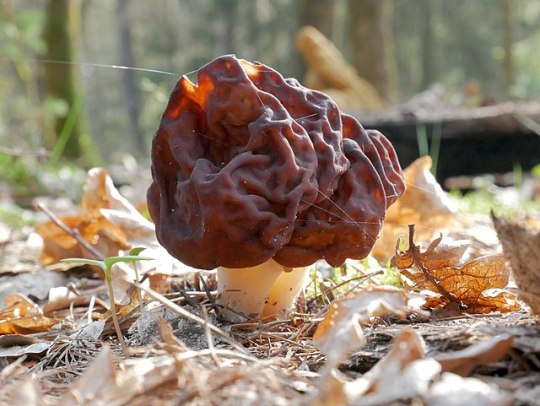
A false morel (Gyromitra spp.); notice that instead of looking like a cone made of honeycomb, it resembles a raisin or a brain on a stalk.
False morels, in the genus Gyromitra, are a more notorious morel lookalike. Several species contain significant levels of gyromitrin, a compound that when boiled or consumed hydrolizes into monomethylhydrazine, a chemical used in making rocket fuel. Consumption may cause gastrointestinal distress, neurological symptoms, kidney and liver failure, coma, and failure of the respiratory and circulatory systems. The most severe cases result in death within a week after consuming false morels. Some species have more gyromitrin than others, and it’s likely that the compound can build up over time in people who eat false morels on a regular basis. While there are purported methods used to reduce or remove gyromitrin from false morels, as a foraging instructor I do not recommend consuming any Gyromitra false morels due to the risk of severe illness.

G. californica. Note that the stipe is not completely hollow inside, but has several cavities divided by fungal tissue. Photo by Alan Rockefeller, CCA-SA-4.0.
So how do you tell the difference? Where true morels look like honeycombed cones, false morels look like brains, oversized raisins, or piles of worms. If you cut a true morel open the stipe will be completely hollow, but the interior of a false morel may have multiple smaller chambers or be completely solid. It is exceptionally important to make sure you get a sure identification on whatever species you are picking, as true and false morels fruit in spring, and sometimes in the same areas.

M. angusticeps
Anything else worth mentioning? Morels are definitely one of those mushrooms you want to cook thoroughly before eating, as raw or undercooked morels can cause gastrointestinal distress. Also, if you hang around mushroom foragers long enough, you’ll hear all sorts of advice–some of it conflicting–about when and where to find morels. It’s true that they fruit in spring, starting in lower elevations where it warms up sooner, and then higher elevations as spring temperatures continue to rise. South-facing slopes that warm up faster with sunlight may also see earlier fruiting. And, of course, places that burned or were logged in the last year or two may see a bumper crop of morels the following spring. Many patches of morel mycelium only last a few years, so the place you found morels one year may not fruit the next.
Beyond that, it’s best to study up on the species of morel that grow in your area. Find out what sorts of habitats they like, if they’re associated with any particular trees, whether they are responsive to burns and other disturbances, and whether there are any toxic look-alikes that grow nearby.
Further reading:
The Great Morel
Mushroom Expert: Morchellaceae
Tom Volk’s Morel Page
Mushroom Appreciation: Morel Mushroom
Did you enjoy this post? Consider taking one of my online foraging and natural history classes, checking out my other articles, or picking up a paperback or ebook I’ve written! You can even buy me a coffee here!
#morels#mushrooms#fungi#fungus#mushroom hunting#mushroom foraging#foraging#wild foods#wild mushrooms#mycology#biology#nature#outdoors#forest#poisonous mushrooms#edible mushrooms
173 notes
·
View notes